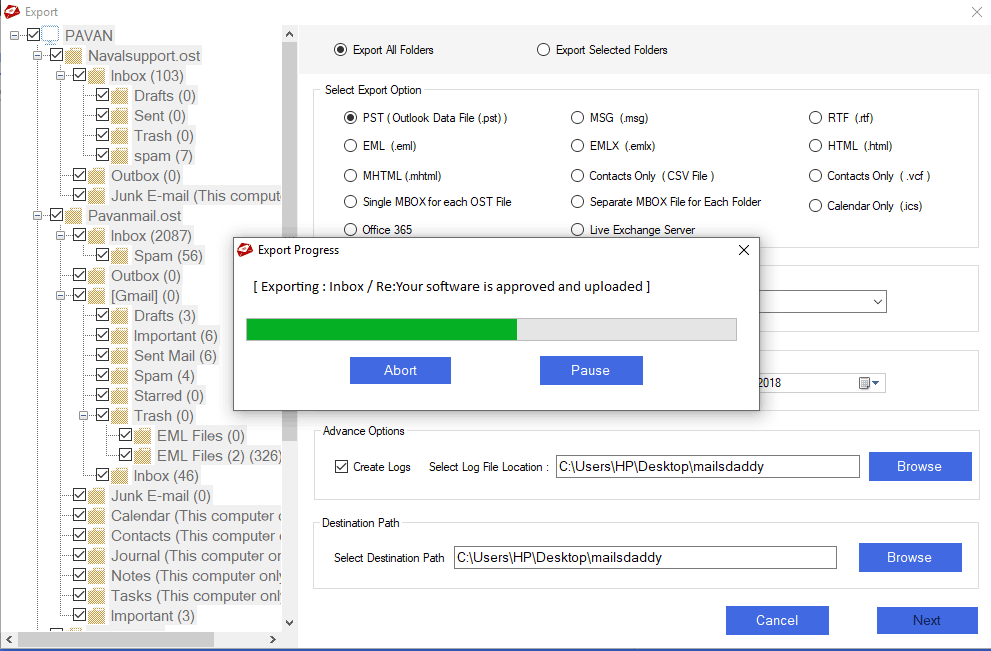How to Convert OST to PST File Format?
Converting OST to PST Format with MailsDaddy
If you are looking for the best solution for converting Outlook OST file to PST format then here you will get a reliable OST to PST converter. Because without using any third-party application, you can’t convert OST to PST file format, so the MailsDaddy OST to PST Converter software is the best tool to solve this issue. By using this software you can perform OST to PST conversion tasks effortlessly.
Benefits of Using MailsDaddy OST to PST Converter
This is a GUI-based application that is available for all Windows editions. The software provides many helpful features to convert OST to PST and other required formats as shown below:
- Recover data from offline, corrupted, or inaccessible OST files.
- Convert all data from OST to PST including emails, attachments, contacts, calendars, tasks, and notes, etc.
- Preview entire data of Exchange Server OST file along with folder structure.
- Quickly convert Outlook OST file to PST format without changing folder tree or HTML formatting.
- Bulk conversion facility to export multiple OST files to PST, EML, MSG, RTF, and HTML formats.
- The Business or Enterprise license user gets options to migrate OST to directly Office 365 or Exchange Server.
- Advance search facility to convert required emails from OST to PST format.
Simple Steps to Convert OST to PST using MailsDaddy Software
This is easy to use solution has been developed with a simple GUI to convert ost to pst. Here you will get step by step guide to perform OST to PST conversion.
- In the very first step, download and install the software on your PC.
- Now launch the application > Click on the Add File button to browse your OST file

- The software will preview all data of your OST file > Click on The Export Button.

- Now Select folders do you want to export > Select PST from Export option > Provide destination path > Click on Export.

- Wait till the software is exporting data from .ost to .pst file format.

In this way you will get all your data of inaccessible OST file in Outlook importable PST format. You can easily add this file to your Outlook profile and continue sending/receiving emails without any trouble. If you want to get more details about this software then visit the official link of mailsdaddy.
Another way for converting OST to PST Format
The above method will help you to recover data from inaccessible, orphaned, or disconnected OST files and convert them to Outlook compatible PST format.
If you are looking for any free or alternative procedure to convert OST to PST along with attachments then it is possible only if the MS Outlook desktop version is installed and you are connected with the Exchange Server. Let’s explore the steps to export OST files to PST format using Outlook ImportExport wizard which is absolutely free and available with MS Outlook itself.
Convert OST to PST Manually for Absolutely Free
- Open MS Outlook and go to the File menu.
- Select the option “Import/Export”.
- Choose Export to a file.
- Select Outlook Data File (.pst) from the options.
- Choose whether to export a selected folder or the whole mailbox.
- Also, check the Include subfolders box.
- Next, select a destination for the Export, and then click Finish.
Note: You will get an Outlook PST file you exported directly from the Exchange mailbox. This method will only work when your Outlook is connected with the Exchange server and working properly and will not work on orphan/corrupt OST data files.
Difference between OST and PST
Microsoft Outlook stores this data (Emails, contacts, tasks, notes and calendar items, etc.) as either PST or an OST file, and both formats are actually quite different as discussed below:
- The main difference between a PST and an OST file is that an OST file is created with an Exchange server and PST is created with POP as well as IMAP accounts.
- OST (Offline storage table) files are usually used even when your Outlook is in online mode since PST (Personal storage table) is used for locally stored data and files.
- OST files allow users to view, read, reply and compose emails even in offline mode since PST files don’t
- As you can see, having your data stored in a PST format seems to be far more beneficial because you can open or import in any edition of MS Outlook and it also reduces the dependency of the Exchange Server environment.